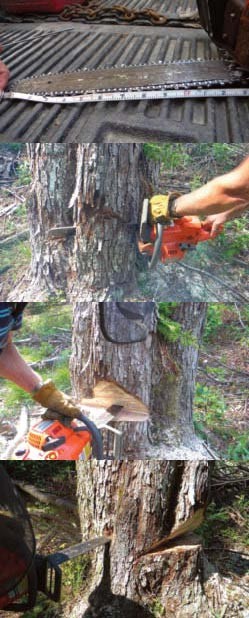
Is longer better when it comes to chainsaw bars? Personally, I like a shorter bar. It allows me to use a saw with a smaller engine, which reduces overall strain on my back and muscles. Plus, shorter bars are inherently safer.
But how do you cut a 34-inch tree with a 16-inch bar? By making a bore cut directly into the middle of your notch, you can cut trees that are bigger than twice the length of your bar.
Before you get started, check to see if the dogs on your saw (the metal spikes at the base of the bar that bite into the tree bark) reduce the effective length of the bar. Once you have the bar’s true length, multiply it by two and add the width of the bar. This is the largest diameter tree you can cut. One caveat here: trees aren’t always perfectly round. And they often have root flare, particularly at the butt, which you’ll need to account for.
Next, do your lean and hazard analysis, plan your escape route, and construct your notch, just like you would on any tree. If the tree has a bad side, position the hinge with the back cut on the bad side and set a wedge. Be sure to leave trigger or release wood on the back of the tree.
Then find the spot one inch up from the bottom of the notch in the dead middle of the notch, and carefully run a bore cut straight into the middle of the face of the notch, right in line with the direction you want the tree to fall. Once the saw is plunged all the way in, carefully pivot the saw on the dogs or base of the bar, making a fan shape inside the tree. Don’t widen the kerf in the middle of the notch – keep it to the width of your bar – but fan out the tree on the inside.
With this fanning motion, you’re removing wood that your saw would not be able to reach due to the bar being less than half of the tree’s diameter.
Now proceed to make the back cut one side at a time, leaving trigger wood in the back. Set a wedge after you do your back cut on each side. With just the trigger wood left, go ahead and cut that and pound in the wedges if needed.
Once the tree is over, check the stump to find any fiber (aside from the hinge) you did not cut, and remember that for next time!


Discussion *